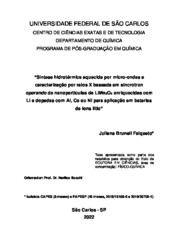Síntese hidrotérmica aquecida por micro-ondas e caracterização por raios X baseada em síncrotron operando de nanopartículas de LiMn2O4 enriquecidas com Li e dopadas com Al, Co ou Ni para aplicação em baterias de íons lítio
Resumen
A facile, fast and efficient microwave-assisted hydrothermal (MWH) route was used to synthetize undoped and doped spinels with Al or Co or Ni. The reaction was carried at low temperature of 140 °C for 5 min in an MWH reactor from aqueous solution of KMnO4, LiOH, acetone (Li/Mn = 1.2; acetone/Mn = 1.1) and the nitrate of the respective cationic dopant. The obtained material was then added in the same reactor with an aqueous solution of LiOH and submitted to a new MWH treatment at the same temperature of 140 °C for 10 min. Finally, a heat treatment in a conventional microwave oven for 4 min was carried out. Three different mol proportions of the dopants (M/Mn = 0.075, 0.025 and 0.010; M = cationic dopant) and two orders of reagents addition using a given proportion were investigated in the syntheses. The best condition was achieved when the precursor of the doping cation was dissolved in acetone using the lowest mol proportion of the reagents. The X-ray diffraction (XRD) patterns of the undoped and doped spinels (Al, Co or Ni) were all similar with highly crystalline diffraction peaks corresponding to the cubic spinel with space group Fd3 ̅m (ICSD-88644). The presence of other phases associate with the dopants and their impact on the crystallization were not detected. All synthetized materials presented a significant amount of potassium birnessite identified by XRD and calculated by Rietveld refinement. The chemical compositions were determined by inductively coupled plasma atomic emission spectroscopy (ICP-AES), resulting in Li1.24K0.05Mn1.92O4.00, Li1.46K0.06Al0.04Mn1.85O4.00, Li1.39K0.07Co0.02Mn1.85O4.00 and Li1.30K0.10Ni0.02Mn1.87O4.00. From the results of small-angle X-ray scattering (SAXS), it can be inferred that nanoparticles were obtained. Beside this, no significant changes were observed by scanning electronic microscopy (SEM), indicating that the low doping with Al, Co or Ni (less than 2.5%) had no effect on the surface morphology of the spinels synthesized by MWH. Afterward, a systematic study to understand in-depth the capacity fading mechanism of LMO nanoparticles when cycled in half cell in two different potential ranges: 3.3 – 4.3 V vs. Li+/Li and 2.0 – 4.3 V vs. Li+/Li was carried out. In the first range, the nanocrystallinity and cationic doping played an important role in improving the electrochemical performance with respect to LMO microparticles. They significantly reduced the charge-transfer resistance, lowered the 1st cycle irreversible capacity to 6%, and achieved a capacity retention between 85 and 90% after 380 cycles with excellent columbic efficiency close to 99% without compromising the specific charge at a high cycling rate of 5C. From X-ray absorption spectroscopy (XAS) measurements, the values of oxidation state of Co and Ni in as-synthesized spinels were found to be ~2.7+ and ~2.0+, respectively. They did not change upon cycling neither in the bulk nor on the surface, implying that Co and Ni did not contribute for the charge compensation and specific capacity. The fitting of the extended X-ray absorption fine structure (EXAFS) indicated that Co and Ni are in the structure of the spinels due to the shorter metal-metal distances than those of the respective standard oxides. Rietveld refinements results confirmed that Li-rich spinels were obtained with part of the Li substituting the Mn into the structure and breaking the symmetry. In the potential range of 2.0 V – 4.3 V vs. Li+/Li, the electrodes of undoped nano-sized and micron-sized spinels presented similar initial values of specific capacity of around 200 mA h g–1 (1C = 296 mA h g–1) at a C/20 rate. The best electrochemical performance was achieved for the nano-sized undoped LiMO with a specific capacity of 201 mA h g–1, 53.5% of capacity retention and 99% of coulombic efficiency after the 55th cycle at a C/20 rate. Results from operando XAS indicated that it is easier to intercalate Li+ ions into the structure of the nano-sized than into the micro-sized spinel which corroborates with its better electrochemical performance. As far as we know, the spectroscopic signature of the Jahn-Teller distortion around Mn3+ in the LMO was obtained for the first time in the present work. Using the proposed cycling program, it was possible to obtain a superior electrochemical performance for the electrode of undoped Li-rich nano-sized LMO. This electrode exhibited excellent cyclability with a capacity retention of 101.5% in the potential range of 3.3 to 4.3 V vs. Li+/Li at a C/5 rate.
Colecciones
El ítem tiene asociados los siguientes ficheros de licencia:

